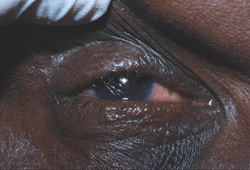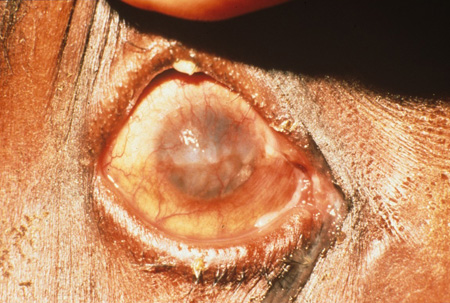History and exam
Key diagnostic factors
common
presence of risk factors
Risk factors strongly associated with trachoma include: residence in or emigration from an area known to have endemic trachoma, poor community hygiene, poor facial hygiene, poverty, and female gender.
Children are predominantly at risk of active infection.
residence in or emigration from an endemic area
Trachoma is confined to those living in the poorest conditions (where hygiene is poor) or those growing up in an area where the disease is endemic.
Trachoma remains endemic in at least 42 countries.[1] It is confined to regions of disadvantage in Africa, the Middle East, Asia, Latin America, the Pacific Islands, and remote Aboriginal and Torres Strait Islander communities in Australia. There are some countries that require further assessment.
at-risk demographic
Active trachoma occurs predominantly in children.[9][10] Children who have had multiple or severe episodes of active trachoma may develop cicatricial disease in later life.
Trachoma blinds a disproportionate number of women.[1][14] This is most likely due to the fact that they have a greater lifetime exposure to young children, which may lead to increased episodes of infection, inflammation, and subsequent scarring.[15]
subtarsal conjunctival inflammation
In severe inflammation the entire conjunctiva may become oedematous and take on a velvety appearance that can obscure the underlying conjunctival vessels.
subtarsal follicles
Pale, raised, discrete circular follicles on the subtarsal conjunctiva are the hallmark of active disease. [Figure caption and citation for the preceding image starts]: Eyelid eversion demonstrating follicles on the upper tarsal conjunctivaFrom the collection of Dr Hugh R. Taylor [Citation ends].
subtarsal conjunctival scarring
Initially appearing as fine linear scars that eventually coalesce to form a dense basket-weave pattern called an Arlt line. [Figure caption and citation for the preceding image starts]: Eyelid eversion demonstrating scars on the tarsal conjunctivaFrom the collection of Dr Hugh R. Taylor [Citation ends].
The scarring may not always be visible.
Scarring is the prelude to cicatricial disease and the pathological process that leads to trichiasis.
trichiasis
Scarring becomes sufficient to alter the architecture of the eyelid, rolling the lid margin inwards and causing one or more lashes to abrade the cornea. [Figure caption and citation for the preceding image starts]: A red eye due to at least 1 inturned eyelash touching the globe (trachomatous trichiasis)From the collection of Dr Hugh R. Taylor [Citation ends].
In hyper-endemic settings, trichiasis may be present in the absence of visible scarring or entropion.
Can be painful and can cause symptoms of epiphora (watering eye) or dry eye.
It is the abrasion of lashes on the cornea that leads to scarring of the cornea and opacification.
corneal opacification and visual loss
The scarred cornea will appear white. [Figure caption and citation for the preceding image starts]: Corneal opacity due to trachomaFrom the collection of Dr Hugh R. Taylor [Citation ends].
Unlike the white of an eye with cataract, the scarring will not be confined to the pupil and will obscure part of the iris-pupil margin.
uncommon
Herbert's pits
Small pits around the margin of the cornea. Represent healed limbal follicles and are pathognomonic of previous episodes of active trachoma.
Although pathognomonic, they are not part of the Simplified WHO grading scheme for trachoma.
Other diagnostic factors
common
asymptomatic
Active trachoma is generally relatively asymptomatic but may present with a discharging, irritated, or red eye.
In resource-poor settings, the diagnosis of trachoma is typically made in an asymptomatic individual as part of a screening programme or as part of a routine health check.
ocular and nasal discharge
Children with active disease may present with this symptom, but more commonly the condition is detected in asymptomatic individuals.
red eye
Children with active disease may present with this symptom, but more commonly the condition is detected in asymptomatic individuals.
painful watery eye
Adults with trichiasis may present with this symptom, but more commonly the condition is detected in asymptomatic individuals.
uncommon
limbal follicles
At times, follicles may form along the superior limbus.
pannus
Vessels grow generally from the superior aspect over the clear cornea.
Risk factors
strong
children (aged 1 to 9 years)
poor facial hygiene
Poor facial cleanliness is probably the most important risk factor in the transmission of trachoma, particularly among children. Studies consistently demonstrate an association between unclean faces and trachomatous inflammation.[9][11][12][13]
Facial cleanliness is important because it is readily modifiable.
female sex
Trachoma blinds a disproportionate number of women.[1][14] Cross-sectional studies have demonstrated this sex imbalance in many countries.
Women have a greater lifetime exposure to young children and this may account for increased episodes of infection, inflammation, and subsequent scarring.[15]
Young boys growing up in poor rural areas tend to be sent away from the family unit to work the land, thus separating them from the young children who harbour the majority of infection. This protects them from repeated inoculation with chlamydia.
poverty
Trachoma is found in the poorest regions of the world, where hygiene remains poor. It is a disease that progressively disappeared from the developed world as community and personal hygiene improved. Blinding trachoma further compounds the vicious circle of poverty as blind relatives must be cared for, further entrenching disadvantage.[16][17]
poor community hygiene
Poor access to good-quality drinking water, lack of adequate latrines for disposal of faecal material, inadequate refuse disposal, the co-existence of animals and humans within the household, and fly density are all risk factors for trachoma.[9][18][19] These various risk factors can be considered under the broader umbrella of environmental community hygiene, and are targeted by public health interventions designed to eliminate trachoma.
crowded households
Facilitates contact between infected individuals.[1]
residence in or emigration from an endemic area
Trachoma is confined to those living in the poorest conditions or those growing up in an area where the disease is endemic. Trachoma is known to be endemic in 42 countries.[1] It is confined to regions of disadvantage in Africa, the Middle East, Asia, Latin America, the Pacific Islands, and remote Aboriginal and Torres Strait Islander communities in Australia. There are some countries that require further assessment.
Use of this content is subject to our disclaimer